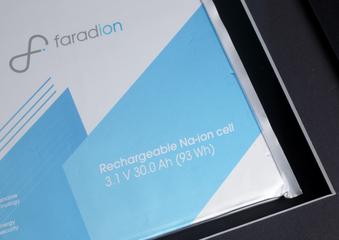
















Perovskite solar cell, made by Oxford Photovoltaics Ltd., Oxford, Oxfordshire, England, 2014
This object marks a demonstrable increase in the efficiency of solar photovoltaics. Currently, the most familiar of solar cells utilise silicon as the light-harvesting element, yet in recent years there has been a push from various sectors to develop cheaper, more efficient, and more sustainable alternatives. Perovskite solar cells use a chemical compound in the perovskite structure as the light-harvesting layer in place of silicon. This particular solar cell was made in 2014 and loaned to the Science Museum in the same year for display in the Atmosphere: Exploring Climate Science Gallery.
The desire to improve on solar technology has increased substantially in recent times due to the growing pressures of the climate crisis. While the sun appears to provide an unlimited source of free energy, the problem of harvesting it effectively is a challenge that researchers globally are working to overcome. Mainstream solar technology – the type that uses silicon – is close to reaching its practical and economic efficiency limit.
This type of situation provides an opportunity for new materials, and Oxford Photovoltaics Limited was thus set up in 2010. Since then, the company has had several breakthroughs, including producing a tandem silicon-perovskite cell which was independently proven to convert 29.52% of solar energy into electricity in 2020. In contrast, standard silicon cells convert on average 15–20% and have an upper limit conversion rate of around 26%.
Perovskite compounds are semiconductors with an organometallic halide or oxide structure that can absorb and emit light. Depending on the ratio and type of halide ions within the compound, the optical bandgap can be tuned to capture different areas of the solar spectrum. The method of deposition – thin film – allows the production of perovskite cells to be low cost, alongside the low cost of the material itself. A drawback is that to increase stability, lead is often used as the metallic element, as found in L2014-4757. Lead is a heavy metal known to cause adverse health and environmental impacts, and some researchers are looking to replace it with a non-toxic alternative. Never-the-less, perovskites remain the fastest improving photovoltaic material ever seen due to their low cost and high performance, with over 10,000 academic publications on the subject between 2012 and 2018 alone.
Details
- Category:
- Electricity Supply
- Object Number:
- 2022-1001
- Materials:
- glass, lead (metal), lead oxide, tin oxide, calcium titanate, iodide and methylammonium
- Measurements:
-
overall: 10 mm x 280 mm x 216 mm,
- type:
- solar cell
- credit:
- Oxford Photovoltaics Ltd




